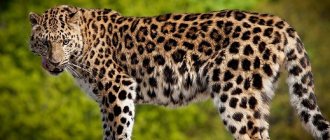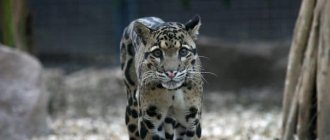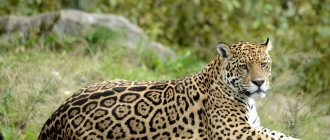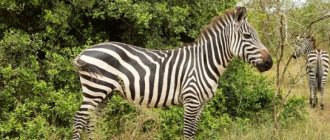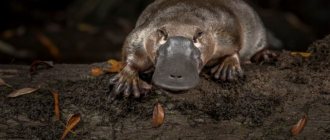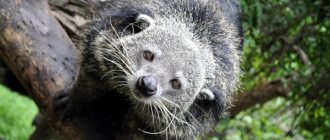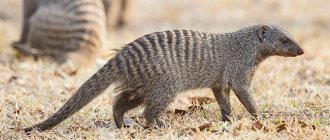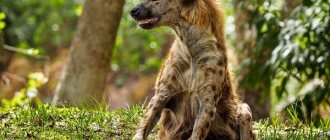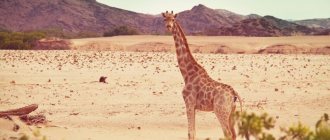- Encyclopedia
- Animals
- Leopard
A leopard is a predator from the genus of mammals, the cat family, a representative of the panther genus, the subspecies of which are listed in the Red Book.
It is a large cat, but much smaller than a lion or tiger. The physique is slender, flexible, muscular and elongated, slightly flattened at the sides. It has a tail that is more than half the length of its entire body. The paws are short, but powerful. The head is round, elongated, the ears are small and round, the eyes are small. The fur grows evenly throughout the body, the wool is coarse and thick. Light red color, with small black spots, changes shade depending on the time of year. The spots are unique to each individual, which is equivalent to human fingerprints.
The length of the body without a tail reaches 190 cm, the weight of females is from 32 to 65 kg, the weight of males is up to 75 kg. The maximum height at the withers is 78 cm.
The leopard's habitat is Africa (forest, forest-steppe and mountainous areas, savanna) and East Asia.
Leopards are solitary by nature, lead a predominantly nocturnal lifestyle, easily adapt to the terrain, so they can easily survive in forests, mountains, even in the desert, it all depends on the quantity and availability of prey.
The predator climbs trees well, often rests on branches during the day and even sets up ambushes, but the main hunting place is the ground. Having seen the prey, the leopard almost silently sneaks towards it up to jumping distance. Next, he jumps sharply and kills by suffocation. If the future food manages to escape, the leopard will pursue it. Uneaten meat is hidden in a tree from other predators. The food consists largely of ungulates (deer, roe deer, antelope, etc.), but if these are absent, it can feast on birds, monkeys and small rodents. Domestic animals also suffer from leopards; they can attack dogs, foxes and wolves. Sometimes it steals prey from other predators or eats carrion. An attack on people is possible.
If they want to reproduce, males can fight and roar loudly, although they themselves are silent. Depending on where they live, leopards breed seasonally or even all year round. Pregnancy lasts 3 months and 1-3 cubs are born. They live with their mother in caves, pits or hide under trees. After 2.5 years, leopards fully mature and grow. Life expectancy ranges from 12 to 17 years.
The number of leopards is decreasing every year due to climate change in the habitat and a decrease in food, as well as poaching, since its rare species are of great value as a trophy
Features and habitat of the leopard
The leopard animal lives throughout Africa and Asia, the north of the Caucasus Mountains and the Amur taiga. Savannas, mixed forests and mountain slopes are the favorite places of these beautiful animals.
For a leopard, adapting to a particular environment is not difficult. In Africa, they thrive in jungles, savannas, semi-deserts and mountains. They also feel good and comfortable in coniferous forests and deep tropical and subtropical mixed forests and mountain slopes in Asia.
A photo of a leopard shows all its greatness and beauty. Looking at them, you understand very well what a strong animal this is. His gaze, fangs and claws inspire unprecedented fear. But along with this, an incredible desire arises to touch this incredibly beautiful fur, even for a split second.
Family relationships
The mating season occurs at the end of autumn - females begin to estrus. Animals do not create permanent pairs, and the female alone prepares a shelter for future offspring. After a pregnancy lasting about 3 months, the female leopard gives birth to 1-4 kittens, immediately covered with fur with spots, but still blind. Cub mortality is high.
A cat child leaves the den at 2-3 months; by 10 months, kittens are able to make long journeys. The brood breaks up when the young are 13-14 months old. A male leopard becomes sexually mature at 2-3 years, a female at 2.
The character and lifestyle of the leopard
In the animal world, leopards, like many other predatory animals, prefer to live alone. The only exception is during marriage.
Just like many other predators, leopards prefer to be nocturnal. During the day, they climb a tree and rest quietly until dusk. They are excellent climbers. And with great ease they can jump onto a tree or rock about 5 meters high.
Any creature can envy leopards' keen vision and keen hearing. The darkness, in which it will be difficult for a person to navigate, is not scary for them; they see everything in it perfectly. Thanks to their ideal protective coloration, leopards can easily camouflage themselves in the natural environment. Even very experienced hunters sometimes find it difficult to spot them.
Only the tail, which always hangs involuntarily from the tree, gives away the location of the leopard. And when he is excited, his tail also moves, which is even more striking. Leopards are a terrible threat to monkeys. As soon as they notice the familiar color, they climb to the very top of the trees and make a wild noise.
And the largest baboons are also wary of encounters with leopards. They prefer to post guards who will watch so that the spotted enemy does not approach.
Agile, secretive and strong, the adult leopard has virtually no enemies. Its main competitors are lions, hyenas, and tigers. They can steal their prey, which the leopard most often hides in a tree.
The tree serves as a place for the leopard to store and eat prey.
Leopards rarely attack people. Most often, this only happens if the leopard is provoked or injured. But people for them are a direct and immediate threat.
Leopard fur has long been valued, and a little later it began to be caught for medical use. And only thanks to the fact that the leopard is listed in the Red Book, open hunting for it stopped.
Interesting Facts
The leopard has very strong muscles. It is capable of killing such a large animal as a buffalo. He calmly carries the carcasses of his victims, which are 2-3 times heavier than himself, over long distances.
A panther is also a leopard, but with an absolutely black skin. Only in very bright light can you see traces of leopard spots on it.
It is interesting that a spotted female leopard gives birth to black cubs, but a panther never has spotted kittens in her litter.
In nature, leopards do not have the same pattern of spots on their skin. Each color is unique, like fingerprints.
If this message was useful to you, I would be glad to see you in the VKontakte group. Also, thank you if you click on one of the “like” buttons:
Types of leopards
There is more than one type of animal, leopard. They are mainly classified according to their habitat.
One of the most prominent representatives, an endangered species, is the Far Eastern leopard, an animal that is also called the Amur leopard. Due to the harsh habitat, this graceful and graceful cat is becoming less and less numerous.
Forest fires, cold and snowy winters, and frequent poaching of these animals have a detrimental effect on their development and numbers. There is only one reserve in which favorable conditions have been created for the life of the Far Eastern leopard. But the area of this reserve is so small that the reproduction of this species of leopard occurs very slowly.
Pictured is an Amur leopard
The animal of Africa, the leopard, prefers to live closer to bodies of water, but can also rise high above sea level - up to 5000 meters. They live unevenly across Africa. The West is not interesting for them; they can most often be found in Morocco and the Atlas Mountains. In semi-deserts, leopards often attack livestock, which is why farmers do not like them.
The African leopard is pale yellow or dark yellow in color with black spots all over its body. The fur on the inside of the tail is white. It has a small head and strong limbs. Leopards are all very nimble and fast animals. They can reach speeds of up to 60 km/h.
Beauty contest winner
Having seen a leopard, it is difficult to remain indifferent to its beauty. Many travelers note its unusual appearance, although it is smaller in size than a lion, tiger or jaguar. The slender, elongated body is drawn in at the sides, and this creates the impression of grace. The maximum weight of females is 50 kg, males weigh more - up to 70 kg.
Leopards reach a length of 135−137 cm, height at the withers from 60 to 78 cm . The impression of elongation of the body is given by the tail, which can grow up to 90 cm. The paws are not long, but slender, emphasizing the grace of the animal.
The head is neatly round in shape, the forehead is convex and powerful. Round ears are widely spaced on both sides of the head, decorated with black spots at the back. The dark-colored nose is wide and sensitive. Elastic vibrissae up to 11 cm long are colored black and white.
Looking into the mouth, you can see 30 sharp fangs; on the tongue there are tubercles covered with hard skin - they are intended both for washing and licking meat from bones. The eyes are small, oval-shaped pupils quickly transform in bright light into a vertical slit.
The paws have claws 5 cm long, chocolate-colored with white trim . Among the interesting facts about the Far Eastern leopard, attention is drawn to its ability to retract its claws into the pad so that they do not become dull when moving over stones.
Nutrition
The main and favorite food of these predators are roe deer, deer, and antelope. The leopard lies in wait for its prey near ponds, jumps into its neck and thus kills it.
These animals hide their prey high in the trees. They can lift up a carcass three times their size. If one of the competitors touched their food, they will no longer eat it. It happens in hungry years that the leopard hunts hares, birds and monkeys. Sometimes it even feeds on carrion. When meeting a fox and a wolf, he simply kills them.
Leopards can steal each other's prey from trees. It usually takes a large leopard two days to eat large prey. This is how a hungry animal eats. A well-fed leopard deals with its prey within five or seven days.
Leopards, to some extent, clear the environment of weak animals. A kind of natural selection occurs with their help.
Characteristics of enemies
Few animals pose a danger to the Far Eastern leopard, since they are not competitors for food. Neither the lynx nor the tiger pose a serious threat; conflicts with the Himalayan and brown bears arise only when females choose shelter for future offspring.
Only wolves in a large pack dare to attack a leopard, but usually it takes refuge in a tree. Most often, wolves catch weak kittens and females. The most dangerous enemy for a wild cat is feral dogs or dogs accompanying the hunter.
In the entire history of observations, there is no documented evidence of a single case in which this subspecies of felines attacked a person. Having seen a person, the leopard wisely hides in the thicket. The lifespan of this rare animal is about 10-15 years in nature, and over 20 in zoos.
Reproduction and lifespan
It is interesting to watch these animals during the rut. Each male tries to win the most beautiful female and prove that he is the one worthy of her. This is determined by their fights and competitions with each other.
As soon as their breeding season arrives, leopards that prefer solitude take off. The den is landscaped by the female. She chooses a place away from prying eyes in crevices, caves or holes under trees.
The female's pregnancy lasts approximately 90 – 110 days. After this, from one to three babies are born, who are completely blind and helpless. They can be spotted or pure black, depending on the presence of pigment.
Only the female raises the babies, but the male is always next to them. Young leopards live with a female from 1 to 1.5 years. During this time, she manages to put them on strong paws and teach them all the tricks of their habitat.
When they reach 30 months, leopards leave their parents' den and begin to lead an independent lifestyle. Animals from the Red Book, the leopard , is one of the most interesting wonders of nature, which we, people, need to preserve at all costs.
Wool cover
The soft fur of the Amur leopard changes depending on the season. In summer, the length of the pile does not exceed 2-2.5 cm on the back and belly, but in winter the coat becomes thicker and grows up to 5 cm on the back and up to 7 cm on the belly.
When composing a message or story about this representative of the cat family, it is necessary to mention its coloring. A distinctive feature of the inhabitant of the Ussuri taiga is the black spots in the form of rings or rosettes covering the background golden-yellow fur. This coloration, despite its brightness, is called protective and helps the predator look invisible in the wild.
The spots on the body are large, 5x5 cm in size, the tail is covered with a pattern of spots and rings . There are no spots on the front of the muzzle, but there are small marks near the mouth, on the cheeks and forehead.
The location of the spots allows scientists observing the life of individuals in the natural environment to identify them, because the pattern on the skin is unique for each animal.
